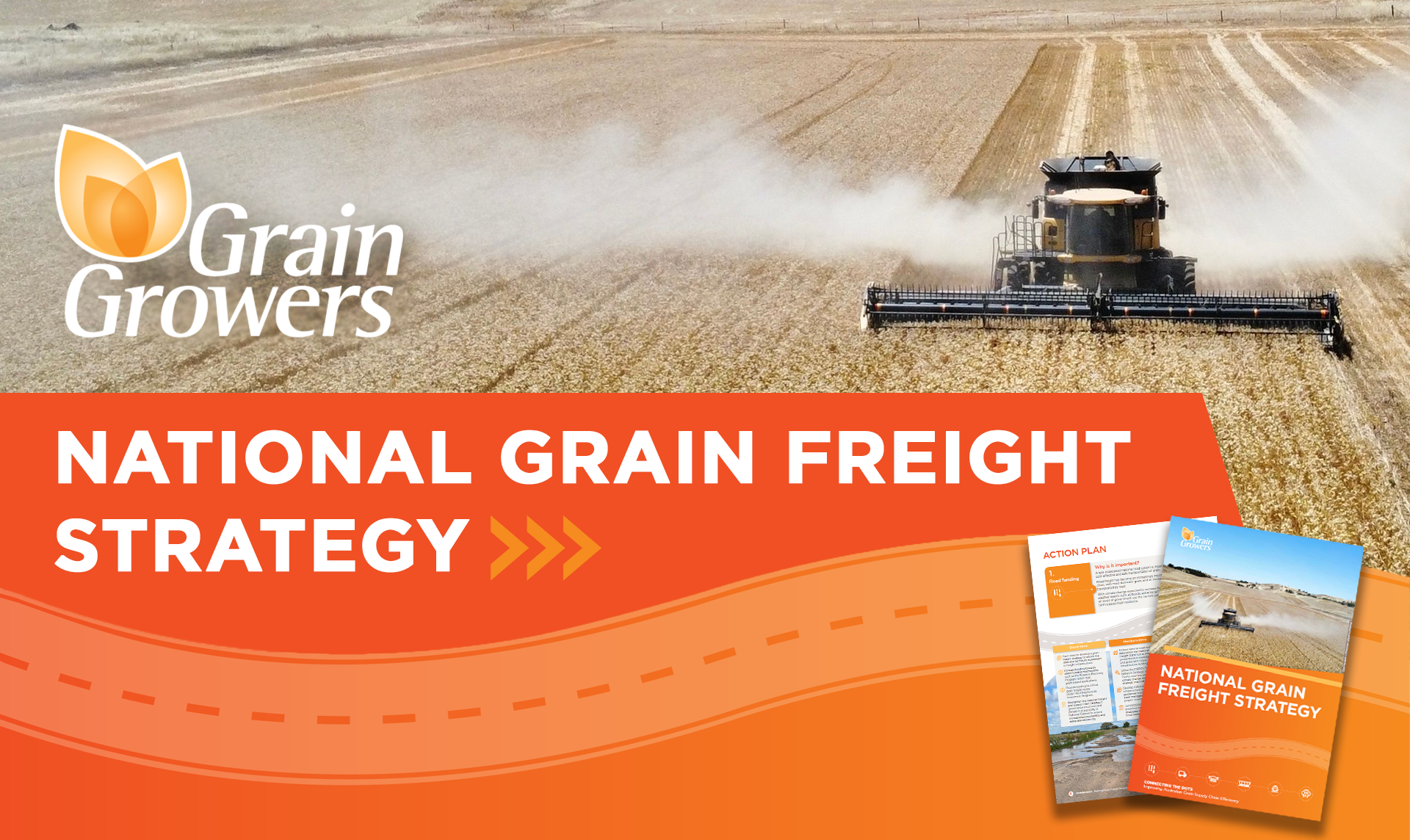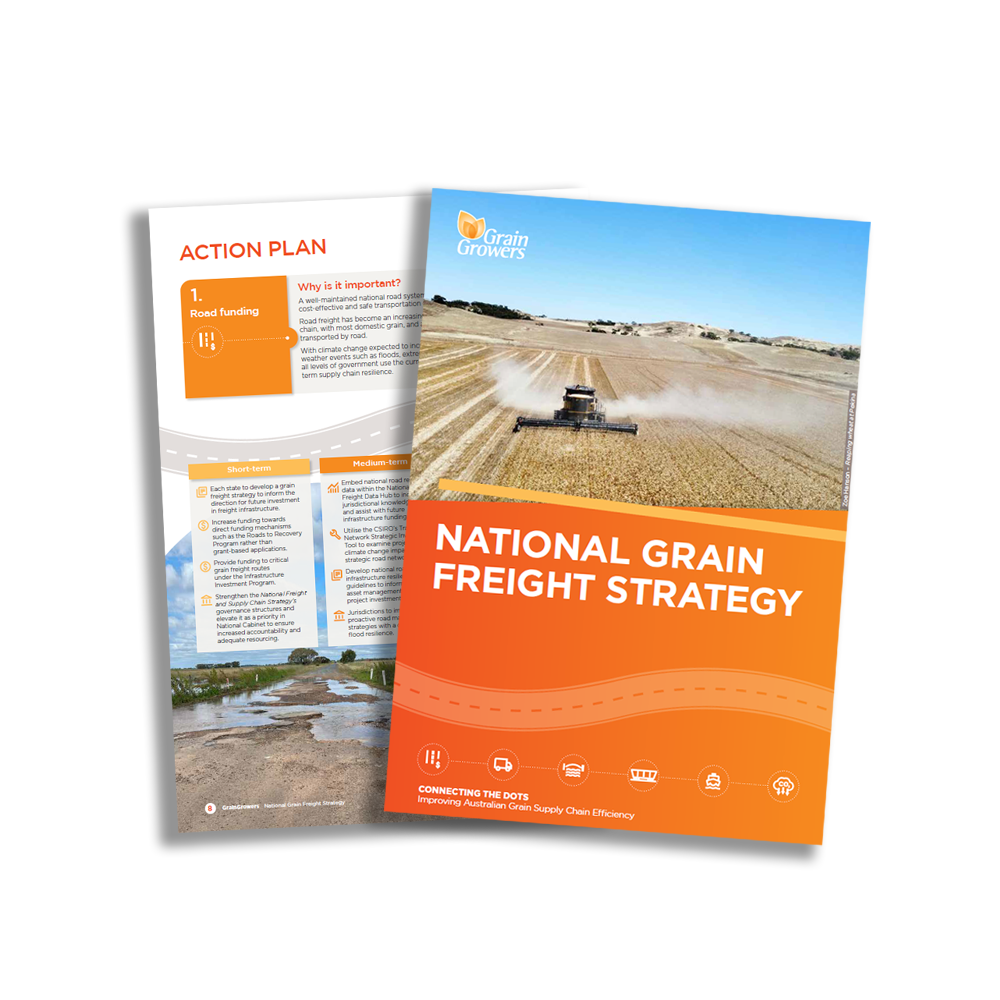GrainGrowers today unveiled its National Grain Freight Strategy with a practical road map for government to help drive Australia’s global competitiveness.
The strategy is designed to increase the productivity and efficiency of the supply chain, driving down costs and delivering savings for Australian growers.
Launching the strategy, GrainGrowers Chair Rhys Turton said a unified and considered approach was vital to address a complex and multi-faceted issue.
The launch was supported by a panel discussion featuring participants across the supply chain discussing some of the challenges and opportunities facing the grain supply chain.
Panel participants included Victorian grower, Ryan Milgate; GrainCorp General Manager, Commercial, Sean Barker; Australasian Rail Association General Manager, Freight and Haul, Georgia Nicholls; and Australian Livestock and Rural Transporters Association Executive Director, Rachel Smith.
Mr Turton explained that the grain freight supply chain was characterised by diverse, complex, and multidirectional freight journeys across multiple modes of transport.
“In 2022-23, a record winter crop production of 65.7 million tonnes was moved from paddocks across regional Australia, by either road or rail to port for export or to domestic markets.”
“The expense of moving grain is the single largest cost of production, with CSIRO modelling highlighting transport costs of $2.1 billion per annum.
“Increasingly, our ability to compete on the global stage is not just determined by what we grow, but also how efficiently and effectively we can get our grain to market. For context, prior to the conflict between Russia and Ukraine, both countries production costs were $70-$120 AUD less than Australia’s.”
GrainGrowers commissioned international consulting firm LEK to develop “Connecting the Dots” report to identify key pinch points in the supply chain. Following the report, GrainGrowers consulted with over 40 stakeholders in the across supply chain to gain further input into the issues.
Mr Turton said GrainGrowers is proud to lead the charge in developing a comprehensive National Grain Freight Strategy.
“By collaborating with industry stakeholders and policymakers, we're paving the way for a more efficient and resilient grain supply chain that meets the evolving needs of Australian grain growers.”
“While growers are at the heart of the strategy, with a key focus on the issues that impact transporting grain off farm such as local roads and bridges, it is vital the approach reflects the views of the broader supply chain.”
“What we have now is a clear strategy built around six key objectives, with the potential to make a real difference to the productivity and efficiency of the grain freight supply chain.”
The framework underpinning the strategy is based on the following objectives:
- Encourage competition and new supply chain entrants;
- Increase scalable capacity within the supply chain;
- Streamline and harmonise regulation;
- Build supply chain resilience;
- Support new technologies and innovation; and
- Enhance freight sustainability.
Mr Turton said the practical application of the strategy was embedded in an action plan focused on road funding, road regulation, bridges, rail, ports and freight decarbonisation.
It outlines ways for government and industry stakeholders to work together, ensuring that Australia’s grain supply chain remains competitive on the global stage.
“The action plan part of this strategy highlights what needs to happen, and the timeline required to deliver results.”
Key elements of the action plan focus on the following issues:
- Road funding: With most domestic grain and an increasing proportion of export grain transported by road, a well-maintained national road system is required. Elements required over the short-term include the development of state-based grain freight strategies; increased funding to direct funding mechanisms such as the Roads to Recovery Program; funding to critical grain freight routes under the Infrastructure Investment Program; and elevating the National Freight and Supply Chain Strategy’s governance structures to a National Cabinet priority to increase resourcing and accountability.
- Road regulation: While Heavy Vehicle National Law was intended to encourage improvements in the roads transport sector, the adoption of High Productivity Freight Vehicles (HPFV) through the Performance Based Standard scheme is constrained by poor regulation and lengthy permit requirements. Short-term actions include a greater streamlining of HPFV regulations; improvements to safety and reduced red tape for HPFVs including crossing rail lines; and increased sharing of resources to local councils to determine road access decisions.
- Bridges: The practical ability of HPFVs to operate is impeded by bridge infrastructure nearing the end of its useful life, with many councils unable to afford bridge replacement and imposing bridge load limits to protect assets. Immediate action is required to identify and fund bridge upgrades on high volume freight routes to increase “whole of route” freight capacity; and targeted funding for cross border bridges to increase load capacity and interstate freight movements.
- Rail: Increasing rail grain freight is a viable way to not only reduce carbon emissions, but also efficiently transport grain long distances from growing regions to port. Unfortunately, a localised rail network undermines the interoperability of the network reducing overall freight efficiency and increasing costs. Urgent work required includes targeted funding to upgrade critical rail freight corridors; the harmonisation of rolling stock access agreements across Rail Infrastructure Managers; an audit of infrastructure standards to identify opportunities for standardisation and expansion; and co-funding for industry to upgrade rail sidings and loading capacity.
- Ports: A well-functioning port system is especially critical to transport grain to overseas markets, however Australian ports and landside logistic chains face major challenges from a growth in trade. Increasing trade will only intensify current issues, with inefficiencies impacting grain exports with spiralling costs and delays. In the short term the industry requires a nationally coordinated approach to port regulation to improve consistency and coordination (including terminal charges); and monitoring of port productivity by the Australian Government.
- Freight decarbonisation: As a hard to abate industry, a nationally coordinated and staged transition is required, to implement a fundamental shift to Australian grain freight. With the commercialisation of low emission road and rail technologies still in its infancy, targeted government support is required to establish low emission pathways for grain freight. Immediate steps required include: the implementation of a National Transport and Infrastructure Net Zero Roadmap and Action Plan; ensuring decarbonisation is included in the National Freight and Supply Chain Strategy; developing a National Modal Shift Scheme to encourage increased grain rail freight; and explore opportunities for domestic production of canola-based biofuels for use in existing machinery to reduce emissions.
“This is not a wish list. It is a pragmatic, strategic pathway forward, and we urge the government to support this and make strategic investments to bring substantial benefits to the industry and the broader Australian economy,” Mr Turton emphasised.
ends
Media contact:
Chris Rowley
P: 0415 140 253
Email chris.rowley@graingrowers.com.au

